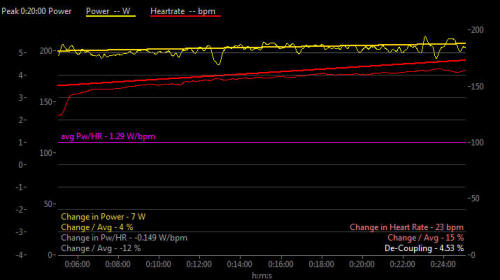FAQ ~ Decoupling?

One of our "data gathering" Sweet Spot Sessions
In my power analysis, you've mentioned
de-coupling, what exactly is it, and why is it important?
Loads of riders this winter.
Where do we start in a concise FAQsheet?
Finding The Sweet Spot
Above, is one of our go-to sessions for gathering lots of
physiological rider data, at little physiological cost. It's a
steady state (iso-power) effort, over a semi-extended time period,
that can be easily replicated and repeatedly used to track aerobic efficiency.
How utterly pretentious does that last sentence sound!?
As this is a FAQsheet, we're not going to go in to too much detail here. Basically, we're measuring how much a riders variable heart rate drifts, against a given constant power output, over a given fixed time period.
As you can see above, and would expect on a turbo, (green) cadence and (yellow) power are, across the 20 minute effort time window, pretty level.
The (red) heart rate starts the effort on the left side grey area of the chart at 142 bpm, and finishes at the right hand side grey marker, at 164 bpm. Which, again, is why we never train by heart rate...
Up Close and Personal
Zooming in to the grey 20 minute effort window, and applying trendlines to
the smoothed data, we can see a change in power of 7 watts over the
"interval" and a change in heart rate of 23 bpm.

This gives a (thick red-line) "cardiac drift" of 4.53%, which is a great indicator of a rider's aerobic efficiency. Anything below 5% is regarded as a good efficiency indicator; so this is good!
We can also see, at this effort and intensity, the (lady) rider is producing (purple line) 1.29 watts per heart beat.
Which in itself means nothing, but it's another data marker we can use to triangulate and compare against other sexy stuff. We can also use it as a seasonal (winter/summer) performance/fatigue tracker.
One thing to consider, when doing this indoors, is thermic stress; or heat build up to us. Yep, indoors you get better control over your power output, but you also generate loads of heat, which has to be dissipated.
The body does this by sending blood to the skin, which (obviously) means it isn't available to go to the muscles. Pumping blood to the skin, will in itself, raise the heart rate; so not all of your heart rate increase is due to muscular oxygen demands.
This factor should be considered before you start getting too carried away with your analysis. It's also why I keep recommending you buy a big fan!
Done in the right way, over the right period of time, and in the right conditions, tracking de-coupling is an excellent way of measuring your aerobic efficiency. Which is a surrogate marker for when your base building work is complete.
The session above was recorded in February, at the end of our 12 week Base Build Programme. This ladies' work is done...








